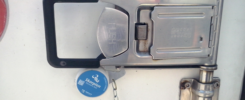LPWAN (Low Power Wide Area Network) is a type of wireless telecommunication wide area network designed to allow long range communications at a low bit rate among connected objects such as sensors operated on a battery.
LPWANs can use licensed or unlicensed frequencies and include proprietary or open standard options.
Examples of unlicensed LPWAN are:
Sigfox, a communications service provider for the IoT
Sigfox, that employs a proprietary technology that enables communication using the Industrial, Scientific and Medical ISM radio band which uses 868MHz in Europe and 902MHz in the US. It utilizes a wide-reaching signal that passes freely through solid objects, called “ultra narrowband” and requires little energy, being termed “Low-power Wide-area network (LPWAN)”. The network is based on one-hop star topology and requires a mobile operator to carry the generated traffic. The signal can also be used to easily cover large areas and to reach underground objects.
LoRa Technology, a Semtech innovation
LoRa Technology offers a very compelling mix of long range, low power consumption and secure data transmission. Public and private networks using this technology can provide coverage that is greater in range compared to that of existing cellular networks. It is easy to plug into the existing infrastructure and offers a solution to serve battery-operated IoT applications.
Types of licensed LPWAN include:
NarrowBand, the radio technology designed for the IoT
NarrowBand IoT (NB-IoT), a Low Power Wide Area Network (LPWAN) radio technology standard that has been developed to enable a wide range of devices and services to be connected using cellular telecommunications bands. NB-IoT is a narrowband radio technology designed for the Internet of Things (IoT), and focuses specifically on indoor coverage, low cost, long battery life, and enabling a large number of connected devices.
LTE-M, the highest bandwidth of any LPWAN technology
LTE-M is an evolution of Release 13 of the 3GPP standard. LTE-M allows to: less energy consumption, and provide deeper coverage to reach challenging locations (e.g., deep inside buildings). This standard will improve upon NB IoT in terms of bandwidth, notably it has higher data rates so is able to transfer information faster and seamlessly at vehicular speeds, making it more open to supporting full mobility. Among LPWAN technologies ensures the maximum safety.
Here is a table of comparison:
| Advantages | Drawbacks | |
| Sigfox | no infrastructure to receive data from sensors; global operator; |
small data transfer for day opportunistic coverage managed by the operator |
| Lora(WAN) | no fee to transmit data from sensors; | opportunistic coverage managed by the service provider or by some local operator |
| Nb-IoT | no infrastructure to receive data from sensors; global coverage; | more expensive radio than the others |
| LTE-M | more security; no infrastructure to receive data from sensors; deeper coverage; | completely new network which requires skills for the installation of equipment and antennas to make it operational. |

